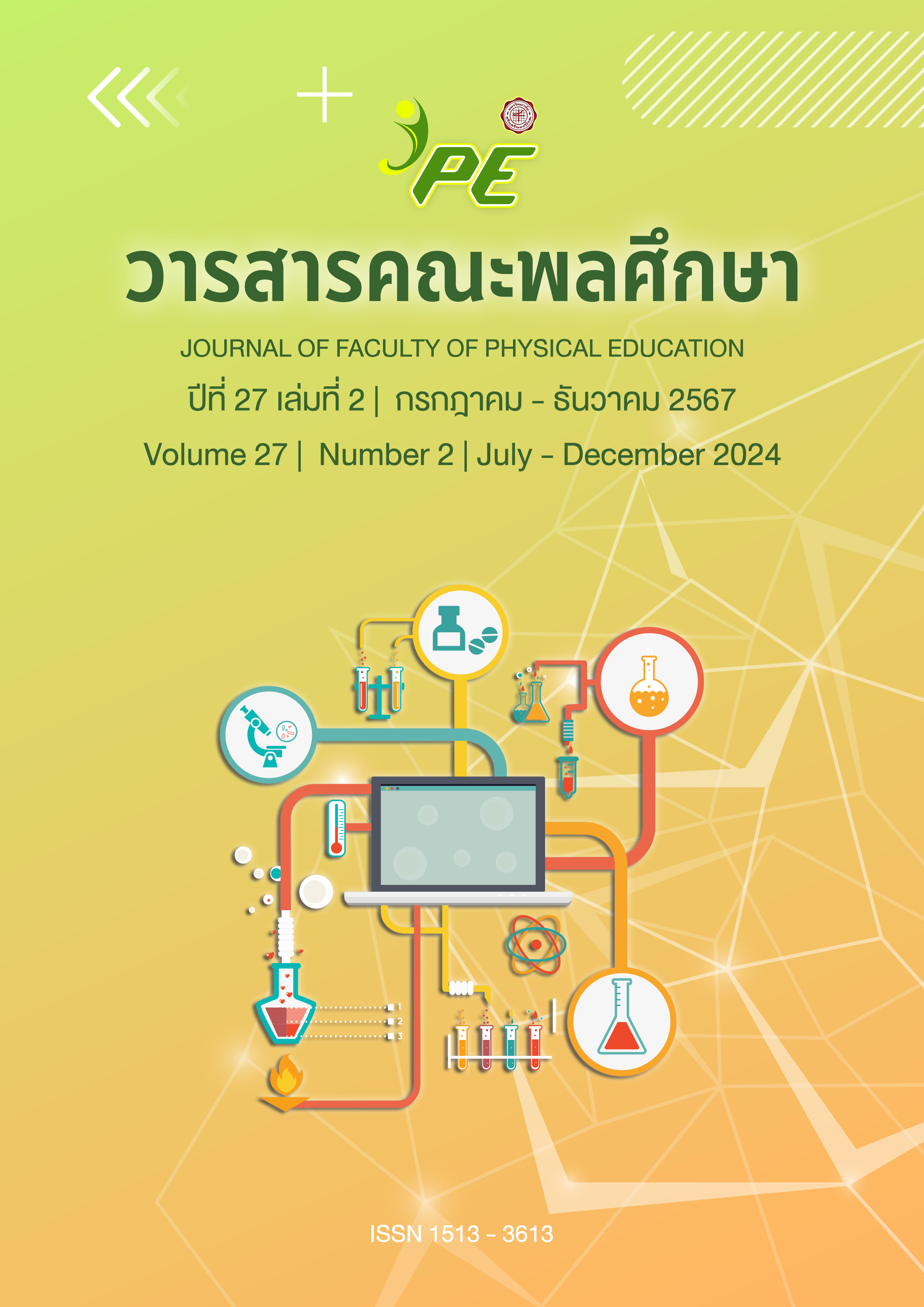A health risk assessment by direct reading measurement for formaldehyde exposure among gross anatomy staff
Main Article Content
Abstract
Formaldehyde is a widely used hazardous chemical, despite its potential risks to human health and classification as a carcinogen. This research assesses health risks from exposure to formaldehyde among gross anatomy staff during four laboratory processes. Data was gathered by interview, direct-reading formaldehyde concentration measurement, and indoor air quality monitors. Results were that work environment formaldehyde concentration exceeded Department of Labor Protection and Welfare standards for two processes. Health risk assessment revealed that employees were at risk of cancer (CR) from exposure to formaldehyde at unacceptable levels in all four processes, while the hazard quotient (HQ) was unacceptable in three processes. Only the body injection process was deemed acceptable. These findings suggest that gross anatomy laboratory staff are at risk of health impacts from exposure to formaldehyde in all working processes. Environmental improvements are needed, including appropriate ventilation systems to control chemical concentration and reduce future employee exposure.
Article Details

This work is licensed under a Creative Commons Attribution-NonCommercial-NoDerivatives 4.0 International License.
Any articles and comments This journal is the opinion of the author. The Faculty of Physical Education doesn't always have to agree. Anyone wishing to publish or distribute a message must obtain direct permission from the author.
References
Khoshakhlagh, A. H., Mohammadzadeh, M., Manafi, S. S., Yousefian, F., & Gruszecka-Kosowska, A.
(2023b). Inhalational exposure to formaldehyde, carcinogenic, and non-carcinogenic risk assessment: A
systematic review. Environmental Pollution, 121854.
Kim, K.-H., Jahan, S. A., & Lee, J.-T. (2011). Exposure to formaldehyde and its potential human health
hazards. Journal of Environmental Science and Health, Part C, 29(4), 277-299.
Klein, L. W., Miller, D. L., Balter, S., Laskey, W., Haines, D., Norbash, A., Mauro, M. A., & Goldstein, J. A.
(2009). Occupational health hazards in the interventional laboratory: time for a safer environment.
Radiology, 250(2), 538-544.
Lakchayapakorn, K., & Watchalayarn, P. (2010). Formaldehyde exposure of medical students and
instructors and clinical symptoms during gross anatomy laboratory in Thammasat University. J Med
Assoc Thai, 93(Suppl 7), S92-98.
Le, A. D. T., Zhang, J. S., & Liu, Z. (2021). Impact of humidity on formaldehyde and moisture buffering
capacity of porous building material. Journal of Building Engineering, 36, 102114.
Liang, W., Lv, M., & Yang, X. (2016). The combined effects of temperature and humidity on initialemittable
formaldehyde concentration of a medium-density fiberboard. Building and Environment, 98, 80-88.
Ministry of Labour (2011). Occupational Safety, Health and Environment Act B.E. 2011. Retrieved 2023
Dec 12 from https://www.tosh.or.th/images/file/2016/osh-act.b.e.2554.pdf
Montgomery, J. F., Storey, S., & Bartlett, K. (2015). Comparison of the indoor air quality in an office
operating with natural or mechanical ventilation using short-term intensive pollutant monitoring. Indoor
and Built Environment, 24(6), 777-787.
National Institutes of Health. (2009). Natural Ventilation for Infection Control in Health-Care Settings.
Retrieved 2023 Dec 11 from https://www.ncbi.nlm.nih.gov/books/NBK143277/
Norkaew, S., Thammabut, P., Chaiyadej, R., Changkaew, K., Yamasamit, N., & Ketsakorn, A. (2021).
Indoor air quality and its associations with skin related syndrome among medical students during gross
anatomy dissection. Journal of Science & Technology MSU, 40(2).
Occupational Safety and Health Administration. Identifying Hazard Control Options the Hierarchy of
Controls. Retrieved 23 Feb 2024, from
https://www.osha.gov/sites/default/files/Hierarchy_of_Controls_02.01.23_form_508_2.pdf
OSHA. (2011). Formaldehyde. us. department of labor. Retrieved 2022 Jun 12 from
https://www.osha.gov/laws-regs/regulations/standardnumber/1910/1910.1048
Pei, J., Qu, M., Sun, L., Wang, X., & Yin, Y. (2022). The relationship between indoor air quality (IAQ) and
perceived air quality (PAQ)–a review and case analysis of Chinese residential environment. Energy and
Built Environment.
Pokorski, M. (2017). Pulmonary care and clinical medicine. Springer.
Qu, M., Lu, J., & He, R. (2017). Formaldehyde from environment. Formaldehyde and cognition, 1, 1-19.
Risner, C. H., & Martin, P. (1994). Quantitation of formaldehyde, acetaldehyde, and acetone in sidestream
cigarette smoke by high-performance liquid chromatography. Journal of chromatographic science, 32(3),
-82.
Suan Prung hospital. (2021). Occupational health, safety, and working environment manual. Committee on
Occupational Health, Safety and Working Environment Suan Prung Hospital. Retrieved 2023 Dec 10
from https://www.suanprung.go.th/suanprung2021/pdf/guide_green.pdf
Tanaka, K., Nishiyama, K., Yaginuma, H., Sasaki, A., Maeda, T., Kaneko, S., Onami, T., & Tanaka, M.
(2003). Formaldehyde exposure levels and exposure control measures during an anatomy dissecting
course. Kaibogaku zasshi. Journal of anatomy, 78(2), 43-51.
The National Institute for Occupational Safety and Health. (2019). Formaldehyde. Retrieved 2024 May 12
from https://www.cdc.gov/niosh/npg/npgd0293.html
Tiruneh, C. (2021). Acute adverse effects of formaldehyde treated cadaver on new innovative medical
students and anatomy staff members in the dissection Hall at Wollo University, Northeast Ethiopia.
Advances in medical education and practice, 41-47.
U.S. Environmental Protection Agency. (1991). Integrated Risk Information System (IRIS): Formaldehyde;
CASRN 50-00-0 https://cfpub.epa.gov/ncea/iris/iris_documents/documents/subst/0419_
summary.pdf#nameddest=woe
U.S. Environmental Protection Agency. (2009). Risk assessment guidance for superfund volume I: human
health evaluation manual (Part F, supplemental guidance for inhalation risk assessment)
https://www.epa.gov/sites/default/files/2015-09/documents/partf_200901_final.pdf
World Health Organization (2010). WHO guidelines for indoor air quality: selected pollutants. World Health
Organization. Regional Office for Europe.


